Review: Japan Airlines B787-9 Business Class (SIN-HND) – The MileLion
Even though Japan Airlines Business Class awards via Alaska Mileage Plan are no longer the stonking deal they used to be, they’re still great value at 25,000 miles each way.
Redemption space between Singapore and Tokyo has dried up till the middle of 2023, but you can still find awards between Singapore and other Japanese cities, via Tokyo. That’s how I booked this Japan Airlines flight, which turned out to be somewhat disappointing…
✈️ tl;dr: Japan Airlines B787-9 Business Class
A claustrophobic design and hard sleeping surface make JAL’s SKYSUITE III Business Class seat an uncomfortable choice for a red-eye flight.
👍 The Good
👎 The Bad
-
Reverse herringbone layout and high walls offer excellent privacy
-
Fast inflight Wi-Fi with time-based packages
-
Old, worn seats that don’t feel clean
-
Very narrow bed with uncomfortable seat cushions
-
Clunky inflight entertainment system blighted by poor navigation design
-
Service routines do not optimise sleep time
Mục Lục
Check-in
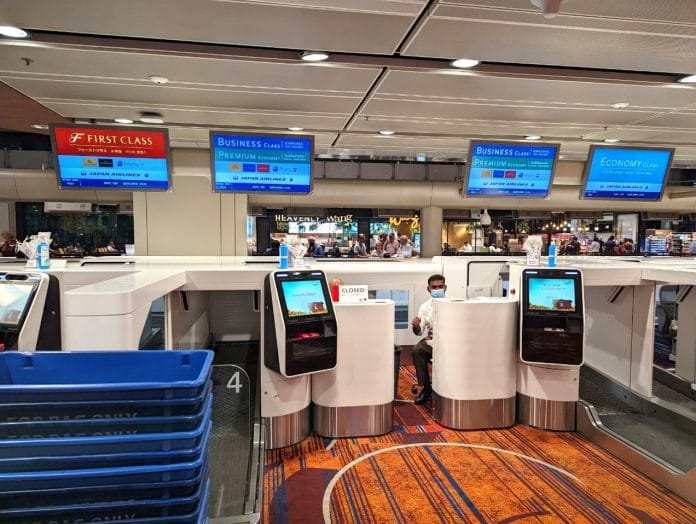
Japan Airlines departs from Changi Terminal 1 and uses the check-in desks at row 1. These open three hours prior to departure, and unfortunately, there’s no early-check in option.
That said, JAL does allow you to print your boarding pass online, so if you have no bags to check you could use that self-printed document to access the departures area, and spend extra time in the amazing Qatar Premium Lounge.
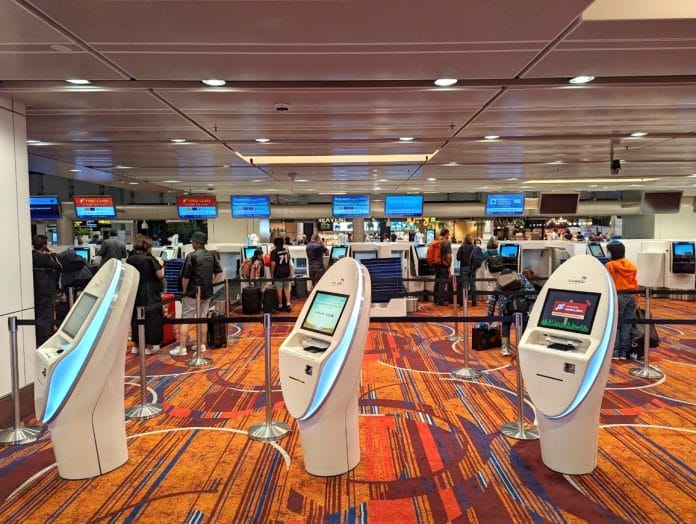
Since I’d booked a SIN-HND-NGS itinerary (Japan Airlines’ married segment logic meant I couldn’t just book a SIN-HND award), my bags were tagged all the way to NGS. However, and this is crucial, all connecting passengers need to collect their bags at the first point of entry, clear customs and then check them again. This means you can leave the airport at HND if you’re so inclined and skip the domestic flight.

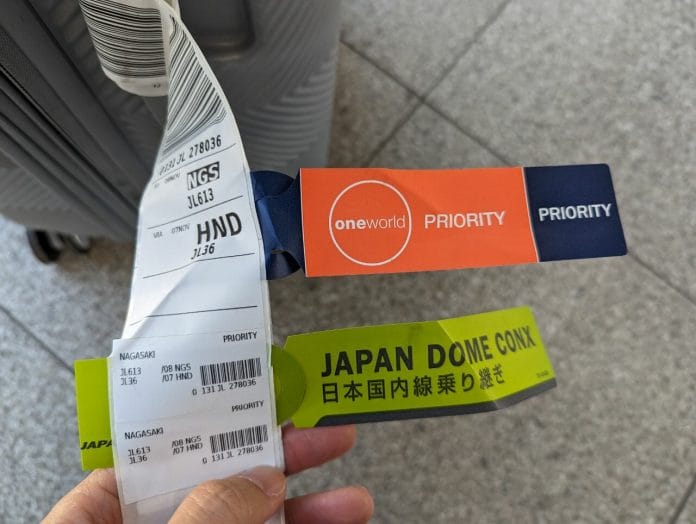
⚠️ Important note
While you can do this on the way to Japan, you can’t do it on the way back. If you book an X-Y-SIN itinerary and miss the first leg, your entire itinerary will be cancelled. This also implies you can’t do it with a round-trip itinerary.
As a Business Class passenger, the check-in staff issued me a map for the marhaba lounge. I had to resist the urge to scream at the passenger checking in next to me “please, please don’t go there!”
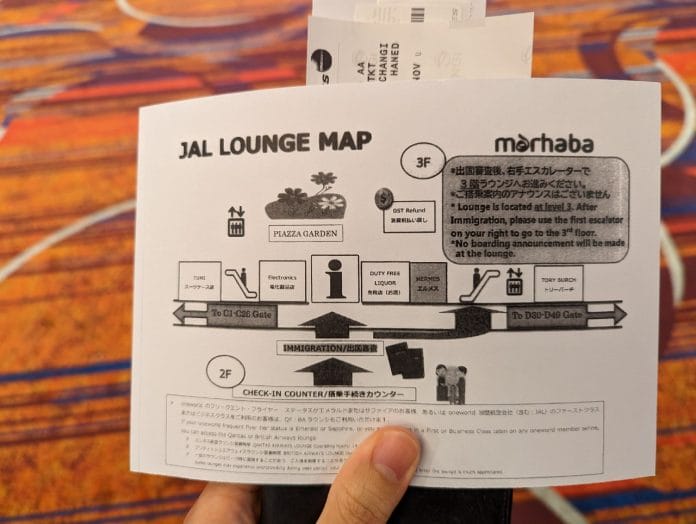
After clearing immigration, I made a beeline for the Qatar Premium Lounge, where I stayed till boarding calls.
Japan Airlines B787-9 Business Class
Flight JL36 to Tokyo Haneda is a red-eye service departing from Singapore Changi at 10.25 p.m, and operated by a B787-9.
Japan Airlines has three different configurations for this aircraft. Today’s was E91, which meant a total of 203 seats split into 52 Business, 35 Premium Economy and 116 Economy.

Japan Airlines uses three main types of Business Class seats for international flying, imaginatively named JAL SKY SUITE, SKY SUITE II and SKY SUITE III.
Type
Config.
Specs
 JAL SKY SUITE
JAL SKY SUITE
JAL SKY SUITE
2-2-2
Width: 52cm
Length: 188cm
Screen: 23″
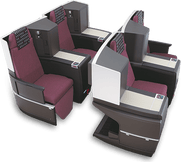 JAL SKY SUITE II
JAL SKY SUITE II
JAL SKY SUITE II
1-2-1
Width: 52cm
Length: 200cm
Screen: 15.4″
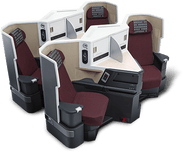 JAL SKY SUITE III
JAL SKY SUITE III
JAL SKY SUITE III
1-2-1
Width: 51 cm
Length: 198cm
Screen: 17″
JAL SKY SUITE is found on the B777s and B787s (usually on the long-haul routes), and is basically your standard Apex Suite, which unique configuration allows all-aisle access even with a 2-2-2 layout (to understand how that works, read this review of Gulf Air).
JAL SKY SUITE II is only found on the B767, and takes the form of a traditional forward-facing 1-2-1 staggered layout.
JAL SKY SUITE III is found on the B777s and B787s (usually on the intra-Asia + Hawaii routes), and comes in a 1-2-1 reverse-herringbone layout.
The E91-configured B787-9s use SKY SUITE III, with Business Class divided into a forward cabin of 28 seats (rows 1-7) and rear cabin of 24 seats (rows 8-13).
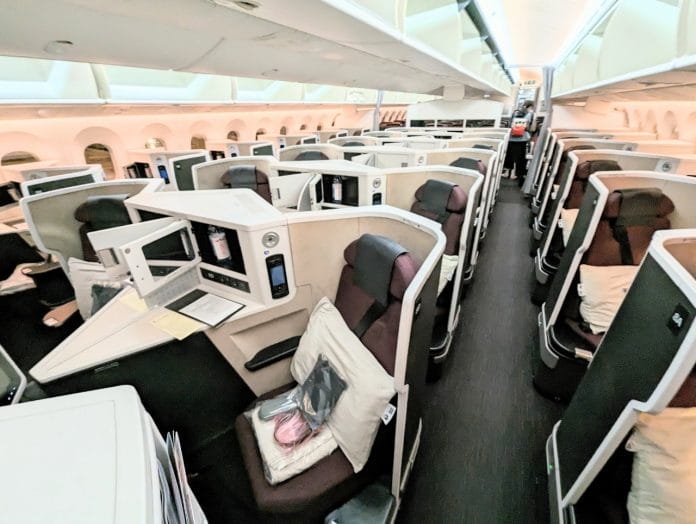
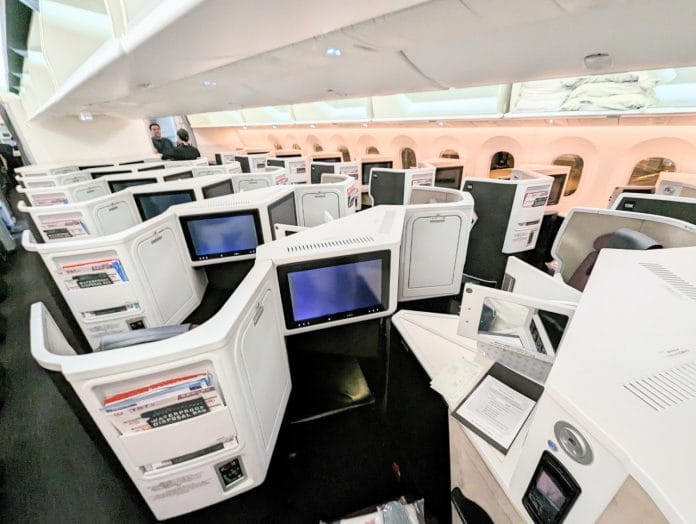
The centre twin seats are the presumptive choice for couples flying together, but as the photo below shows, you won’t be see much of your companion the whole flight.
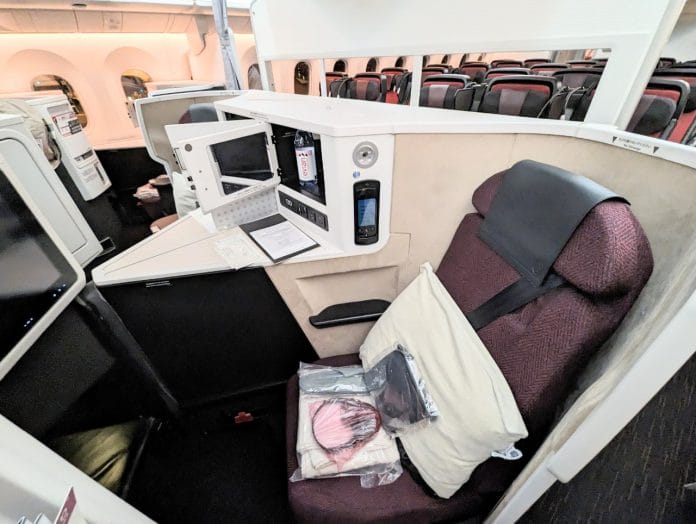
According to JAL, the centre seats have a “movable central divider”, but I didn’t see any way it could be adjusted.
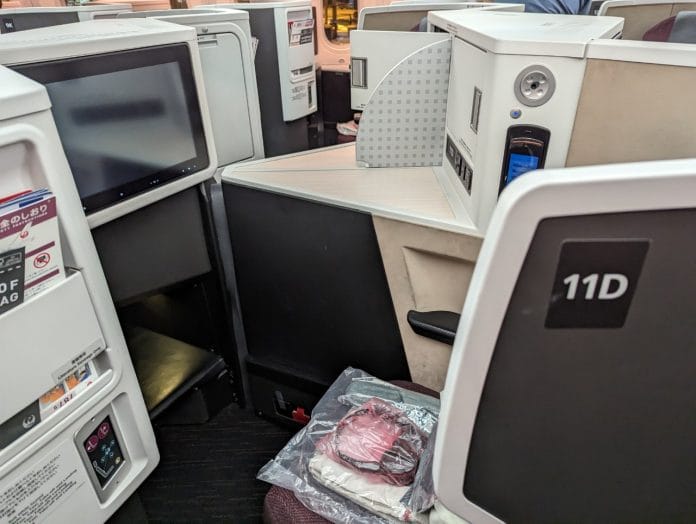
On the flip side, it means that solo travellers who end up in the centre seats will still have a great deal of privacy, especially since the larger-than-usual privacy wings provide a good amount of visual separation from the aisle.
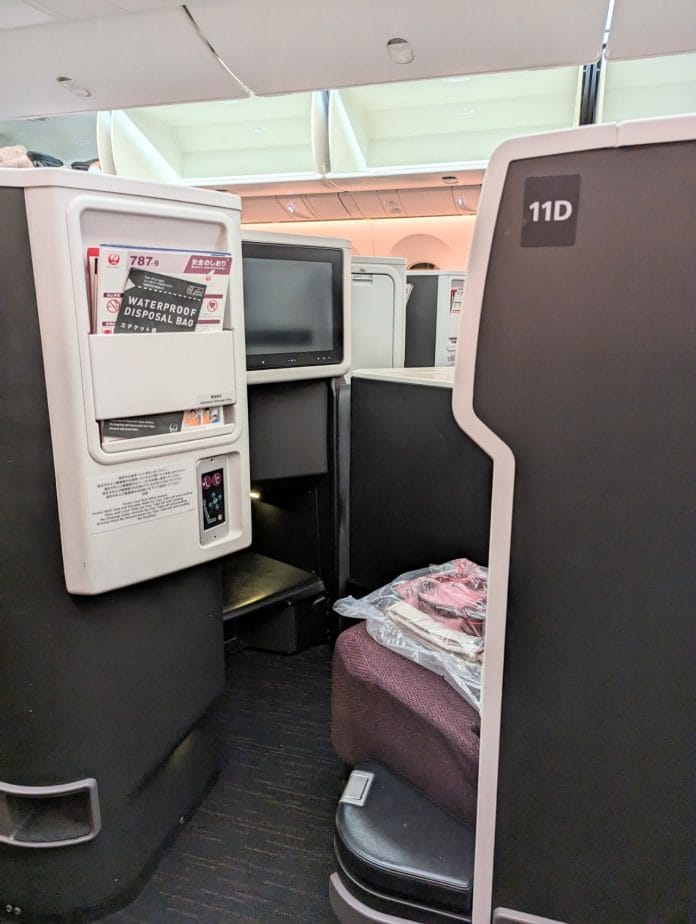
I choose seat 11A by the port side of the aircraft. It’s a bit curious that this seat requires a three-point seatbelt, although the shoulder strap only needs to be fastened during take-off and landing.
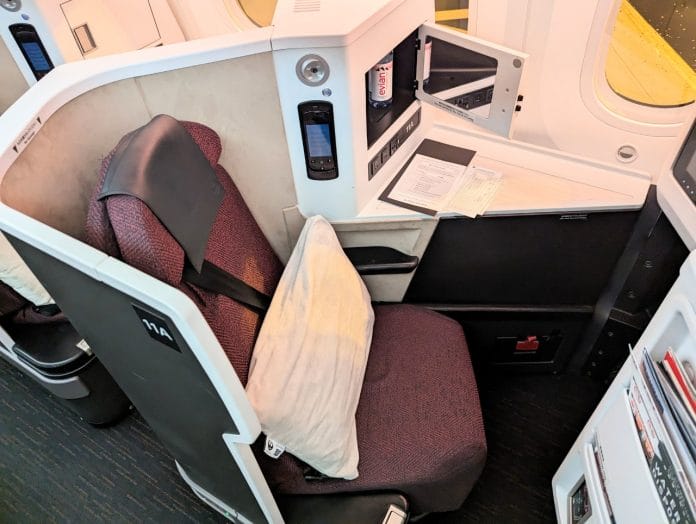
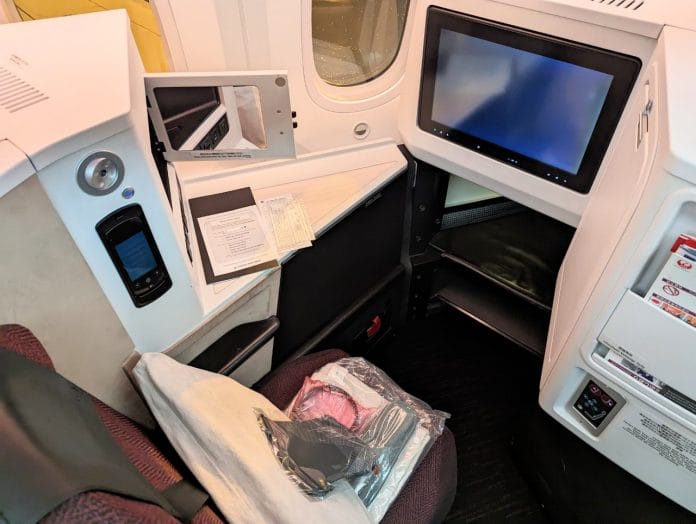
While I like reverse herringbone seats in general, Japan Airlines’ version is incredibly tight. I’m talking near coffin width (roughly 20″), not helped by the fact the compartment where the tray table is stowed juts out ever so slightly. This further cuts into your personal space, and forces you to squeeze out of the seat sideways or else bump your knee.
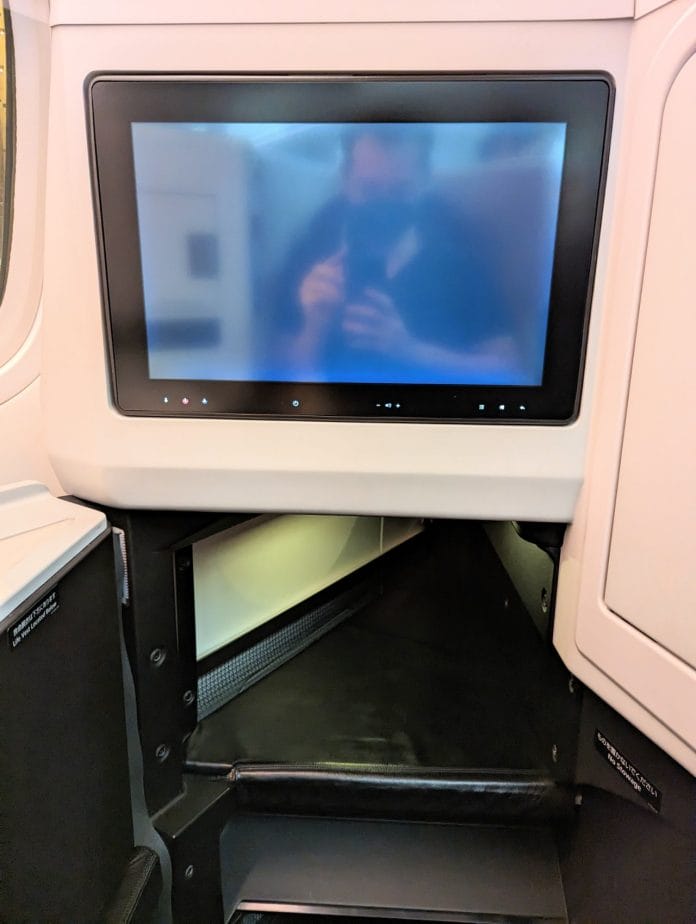
It’s not just in your mind. Young Travellers of Hong Kong has a technical explanation for the seat feels so claustrophobic:
There’s a reason for this – Japan Airlines’ reverse herringbone seats were designed to be high-capacity, so the middle seats are actually “staggered” upon one another. This means that the footwells of the middle seats are atop one another, as opposed to being beside each other. As a result, the seat pitch and width of these seats are both less than that of a reverse herringbone seat on, say, Cathay Pacific’s 777, despite the fuselages of the two planes being just as wide.
Some breathing room can be obtained by collapsing the armrest, though you’ll still feel it acutely when you’re lying full flat and trying to sleep.
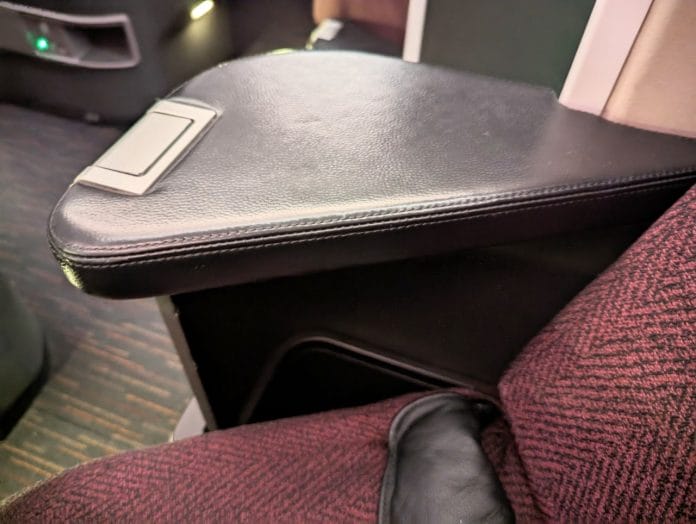
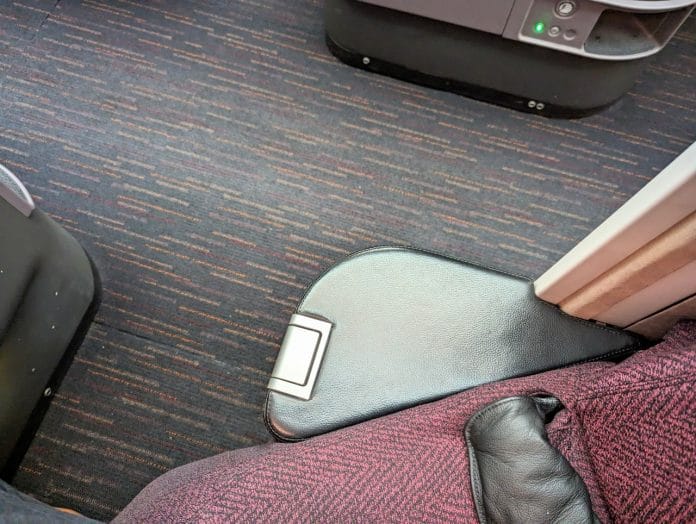
Moreover, the seat felt worn and dirty. I’ve never been a fan of fabric seat covers because I think it’s gross how much sweat and spills they absorb over the years (it’s much easier to clean leather), and there were visible stains all over. It just didn’t feel clean at all.
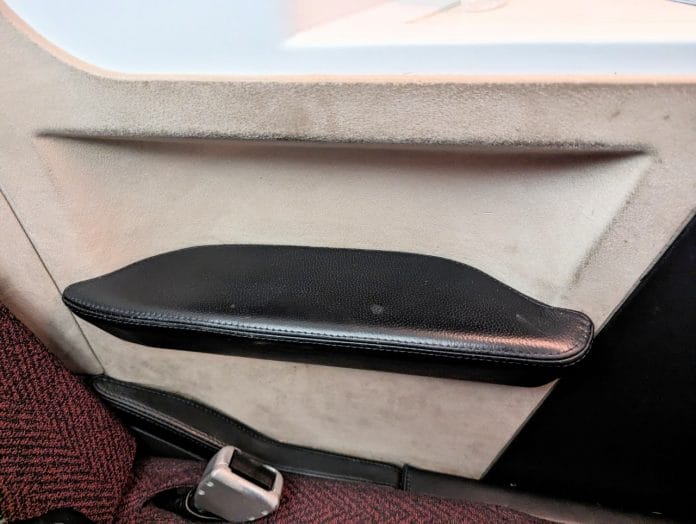
Storage space was sorely lacking. The side console is small (and in any case, no items can be placed here during taxi, take-off and landing), as is the cupboard. It’s so shallow you can just about store a bottle of mineral water and little more.
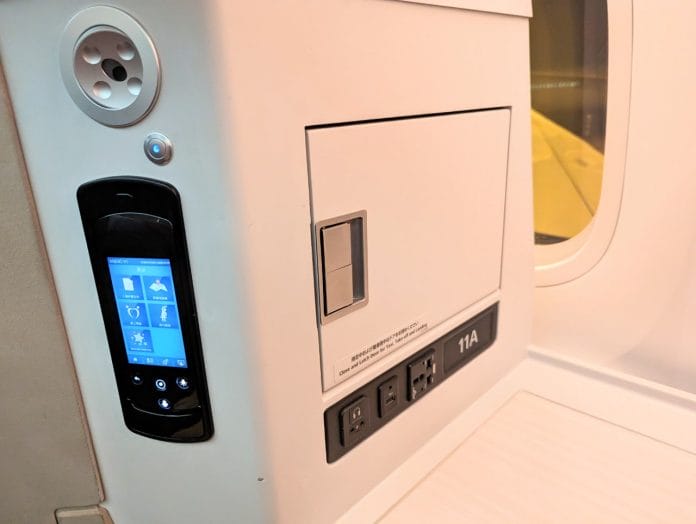
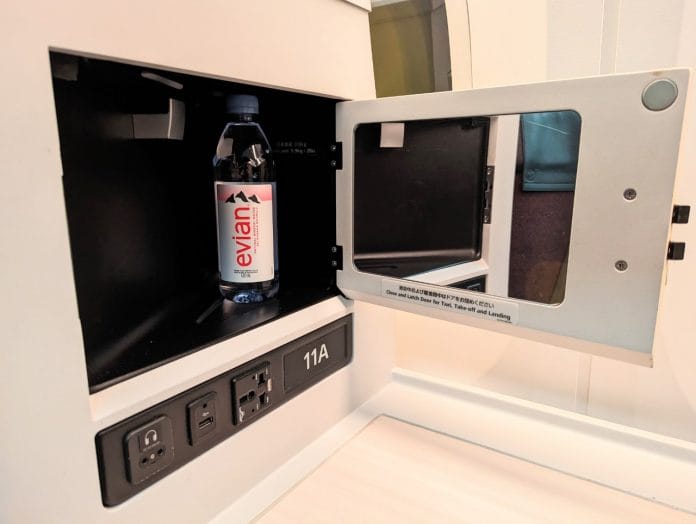
Below the storage cabinet was a headphone jack, USB Type-A port and universal charging outlet.

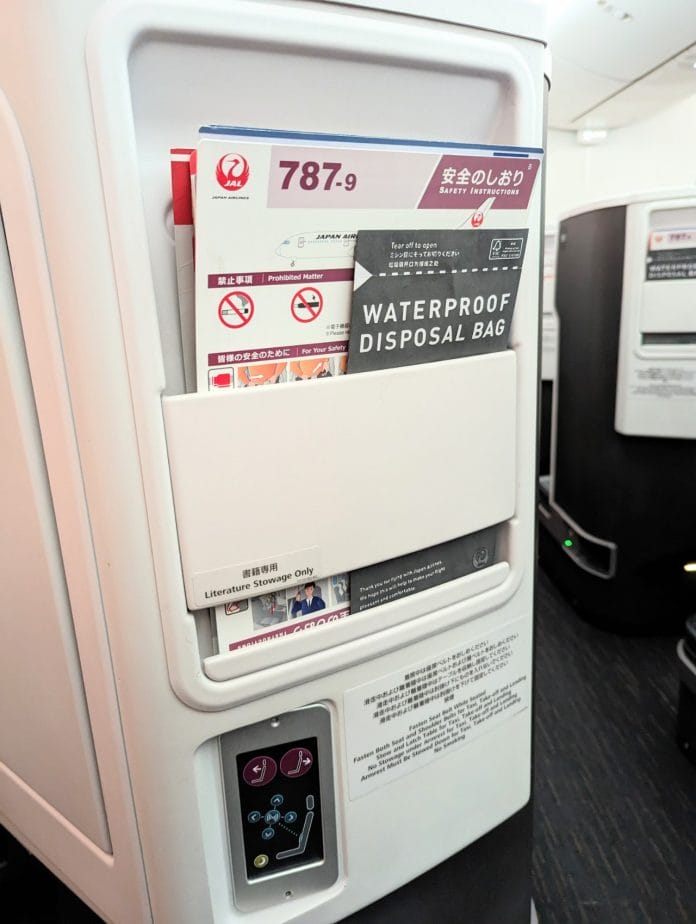
Below the literature pocket were the seat controls, which were quite basic. You could only put the seat up or down, as well as adjust the lumbar support and massage function. It was not possible to control individual components of the seat, such as the footrest.
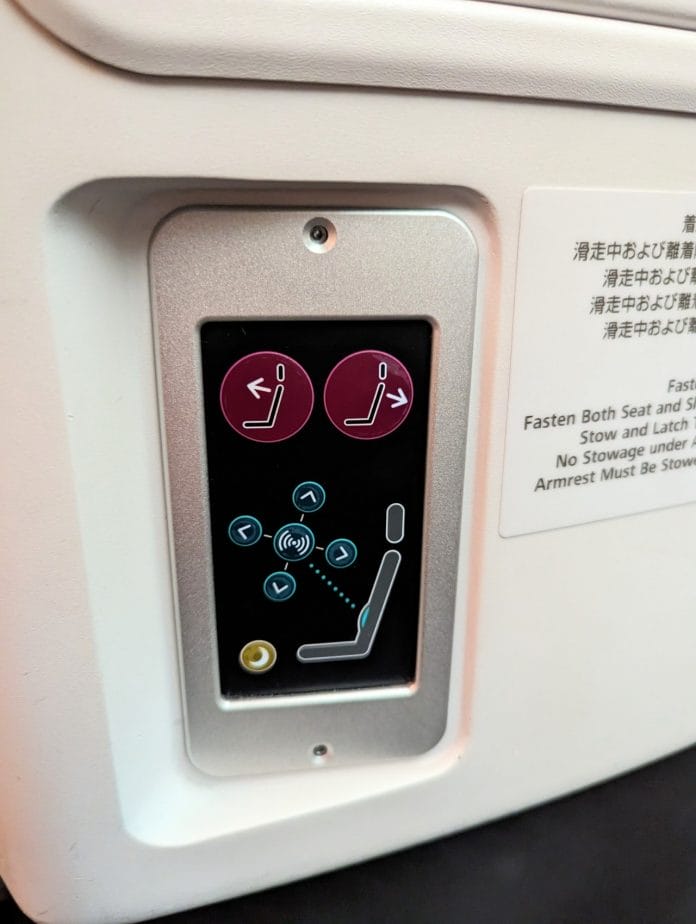
The seat’s tray table unfolds from a panel next to the IFE display. The pivoting design allows it to be pushed away from the passenger even when loaded, in case you wish to enter or exit your seat during meal service.

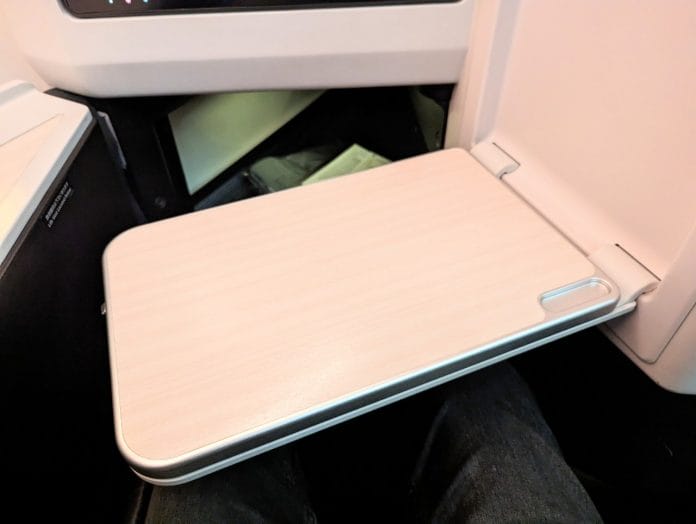

Amenities
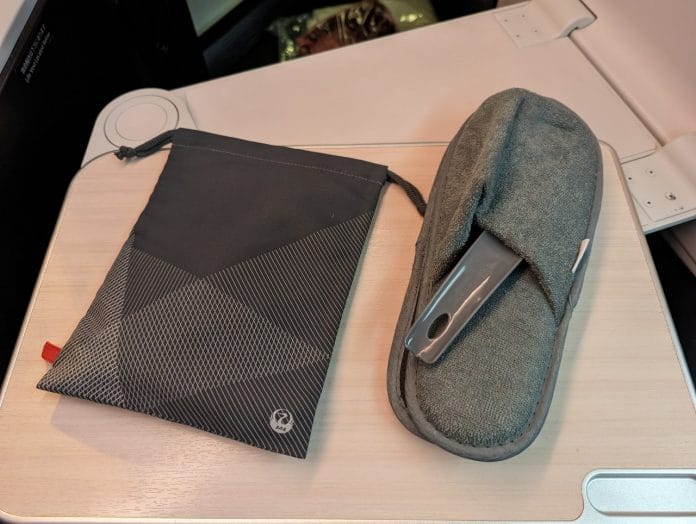
Waiting at each Business Class seat was an amenities kit, together with a pair of slippers and a shoehorn.
JAL has two types of amenities kits- a more elaborate one designed in conjunction with Maison Kitsune, and a basic unbranded one. Routes between Japan and Hawaii, Southeast Asia and India receive the basic one. This has an eye mask, toothbrush kit, ear plugs and a moisture mask.
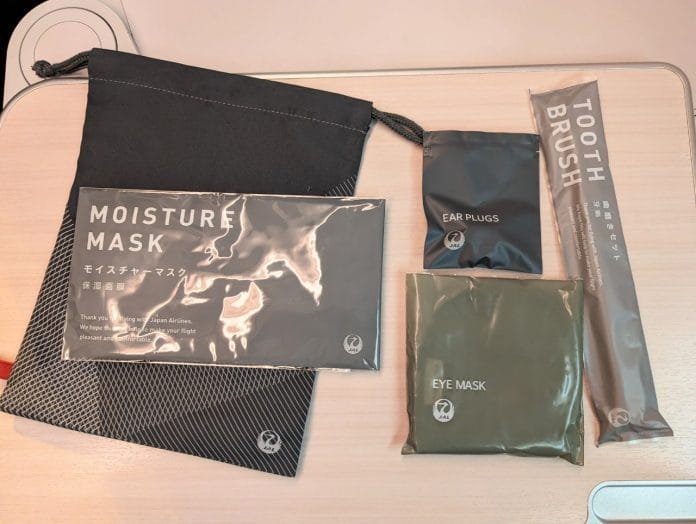
If you’re flying between Japan and Europe, USA, Canada and Australia, you’ll get a much nicer pouch, but the contents are otherwise largely similar.
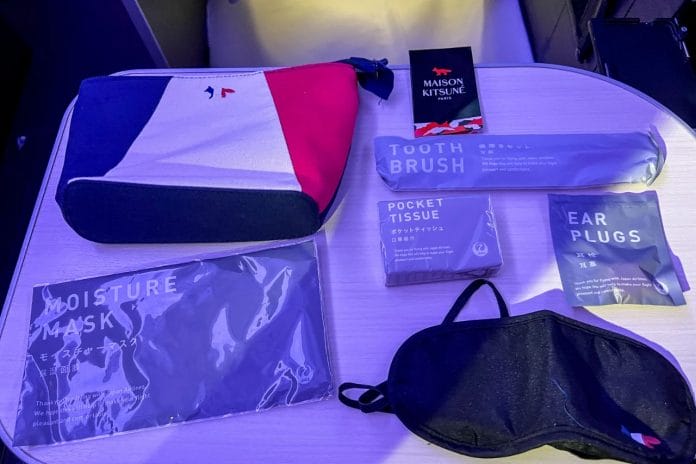
A blanket and pillow were also provided, though something was amiss. The pillow came in an airweave case, but I can’t remember airweave pillows ever being this limp. I deeply suspect that a substitution was made, since the pillow case was clearly too large for the pillow. The website partially confirms this, since it says that airweave pillows are only offered on routes between Japan and Europe, USA and Australia.

Food & Beverage
I’m of the opinion that the chief goal of a red-eye service should be to maximise sleep. Therefore, I found the service routines on this flight rather odd.
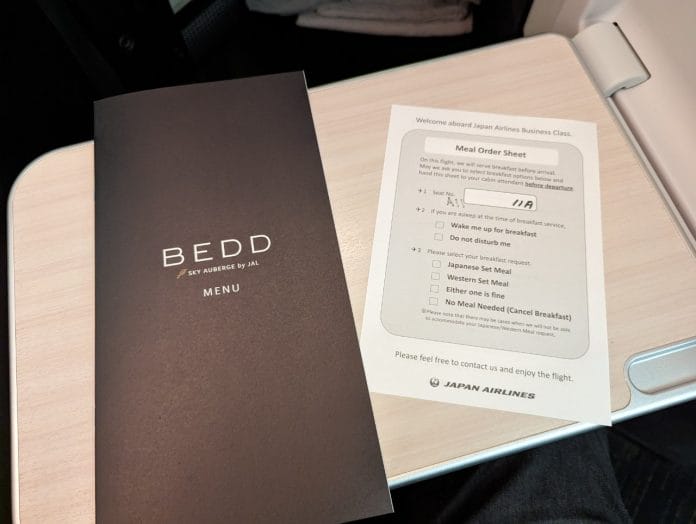
A menu and order sheet were waiting at each seat upon boarding. The sheet allowed you to indicate whether you wanted a Japanese or Western set for breakfast (or to be left alone to sleep).
If you’re curious about what will be served on your flight, you can visit this webpage to look up the meals three months in advance.

However, after take-off passengers had to wait until a small amuse bouche service was completed before the cabin lights were turned off. By the time this happened, almost one hour had passed since departure. I don’t need to tell you that’s a lot of lost sleep on a 6h 35min flight, especially when the cabin lights come on again 1h 40mins before landing for breakfast service!
Given how mediocre the amuse bouche was, I’d have preferred they do away with it altogether and just go lights out immediately after take-off. There were three canapes: smoked duck & orange, skewered pickles and mushroom polenta. It looked like the leftovers from a networking session, and went mostly uneaten.
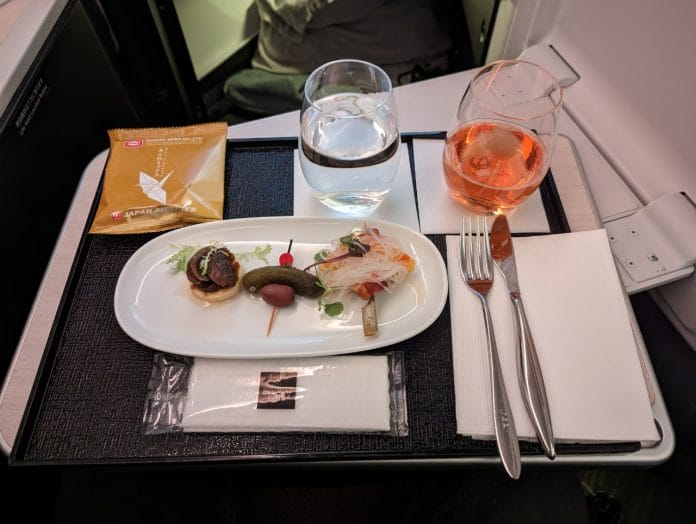
I chose the Japanese option for breakfast, which came with chicken teriyaki and steamed Koshihikari rice. Vinegared octopus, simmered chicken with ginko nuts, assorted Japanese pickles, miso soup and fruits rounded out the bento box.
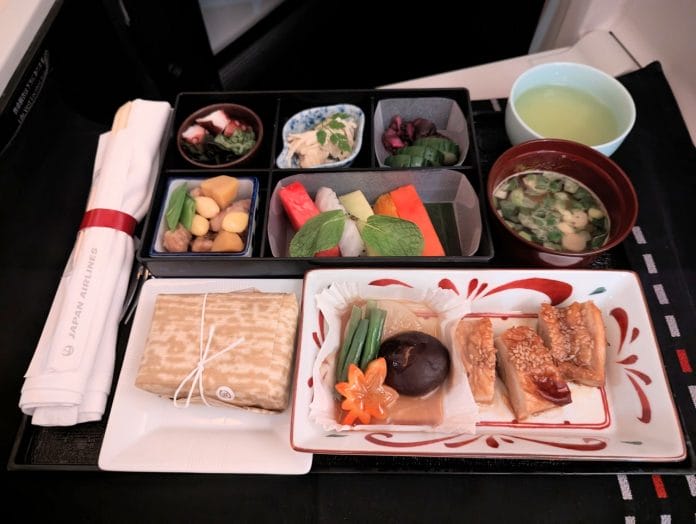
I’d say the meal quality was OK (Japanese rice has a way of making everything better), but clearly not on the same level as the catering out of Japan. The octopus was rubbery, and the chicken tasteless apart from the sauce.
Japan Airlines serves champagne in Business Class, but interestingly enough, a rosé (Besserat de Bellefon). I personally didn’t mind, but I’d have thought most passengers would prefer a classic brut, with rosé as an alternative option.
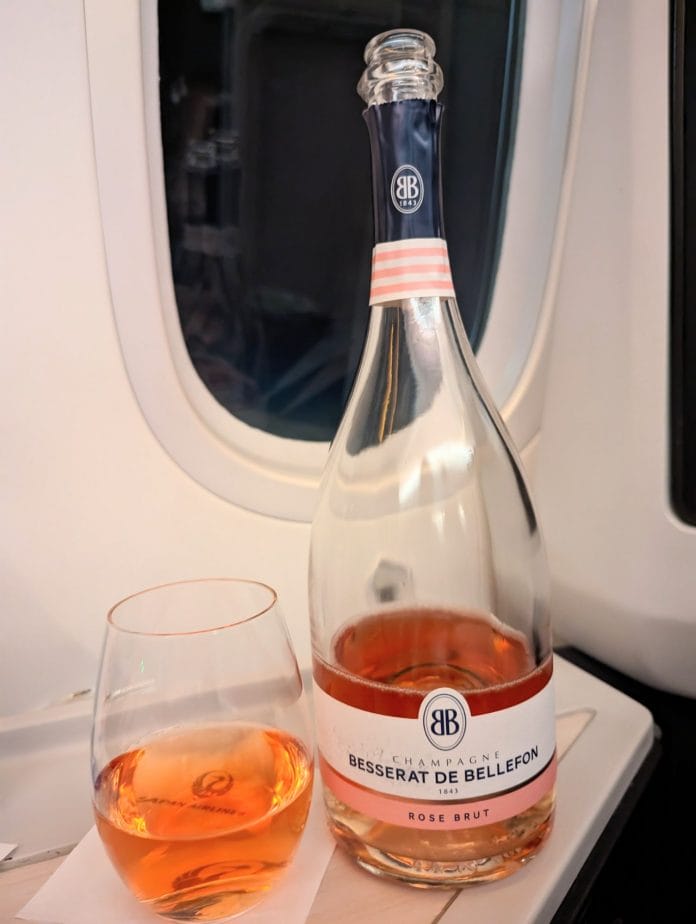
The full wine list read as follows.
🍷 JAL Business Class Wine List
Wine
Type
Vivino
Besserat de Bellefon Rosé Brut Champagne N.V.
Champagne
3.9/5
Albert Bichot Mâcon-Lugny Les Charmes 2018
White
3.8/5
Château Mercian Moegi 2021
White
3.3/5
Castello Nipozzano Chianti Rùfina Riserva 2016
Red
3.8/5
Meyer Näkel Pinot Noir Edition Old Vines 2018
Red
3.6/5
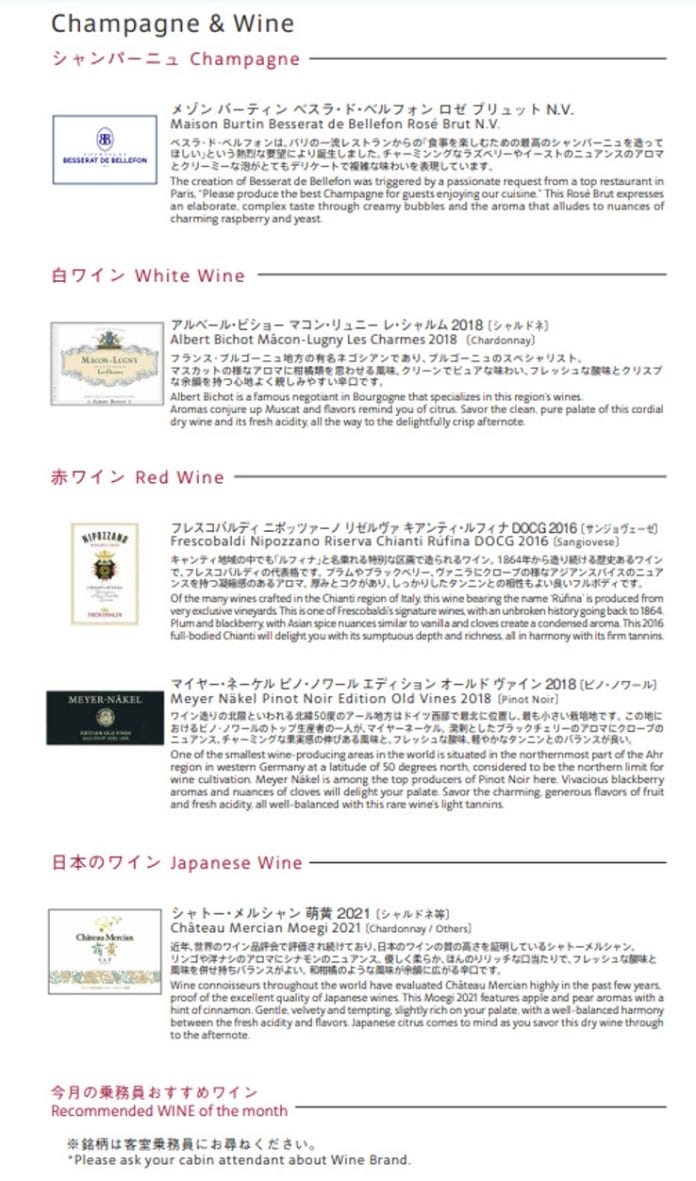
Two kinds of sake were served, along with various spirits and liquors.
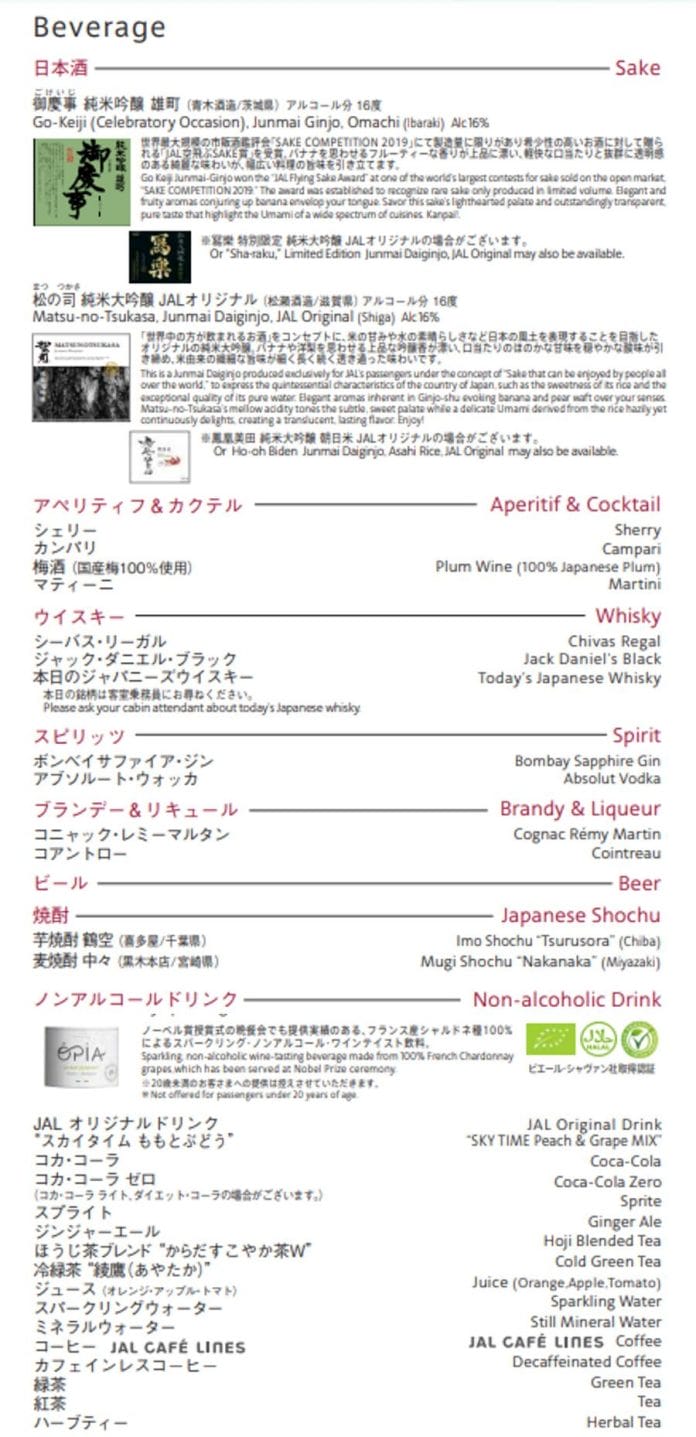
Inflight Entertainment

Each Business Class passenger has a 17-inch personal IFE touchscreen. It’s a last-gen screen, so don’t expect 4K resolution or snappy responsiveness; you need to press rather hard for inputs to be registered.
This is powered by Magic-VI, which I hate with a vengeance. Unlike other inflight entertainment systems, it’s not possible to browse the selection on the main screen. You instead select what you want to watch on the handset, which then projects the video on the main screen. Once the video is playing, you can touch the main screen to adjust the volume or skip forward/backwards, but if you want to change the selection it’s back to the handset.
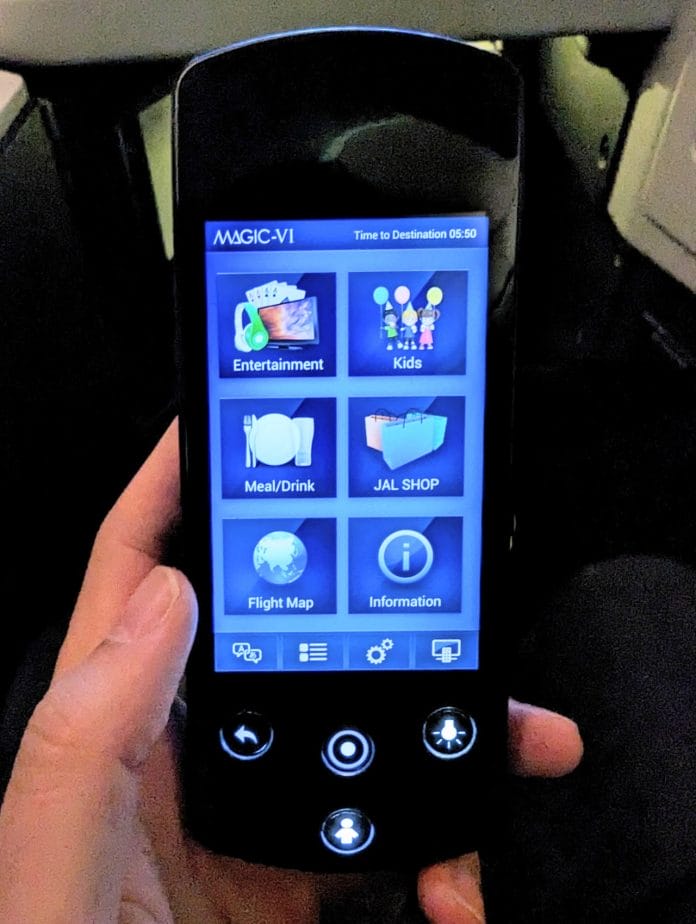
Browsing is slow on the handset due to the limited screen size, and the fact the system doesn’t feature nested options. What this means is that a given title can appear multiple times, depending on the language tracks available (versus a nested system which would show the title once, then let the passenger select the language on the next screen).
For example, notice how The Lost City is listed three times. Multiply that by the number of titles in the library, and you’re looking at a lot of scrolling. It’s frustratingly inefficient, and appallingly-designed UX.
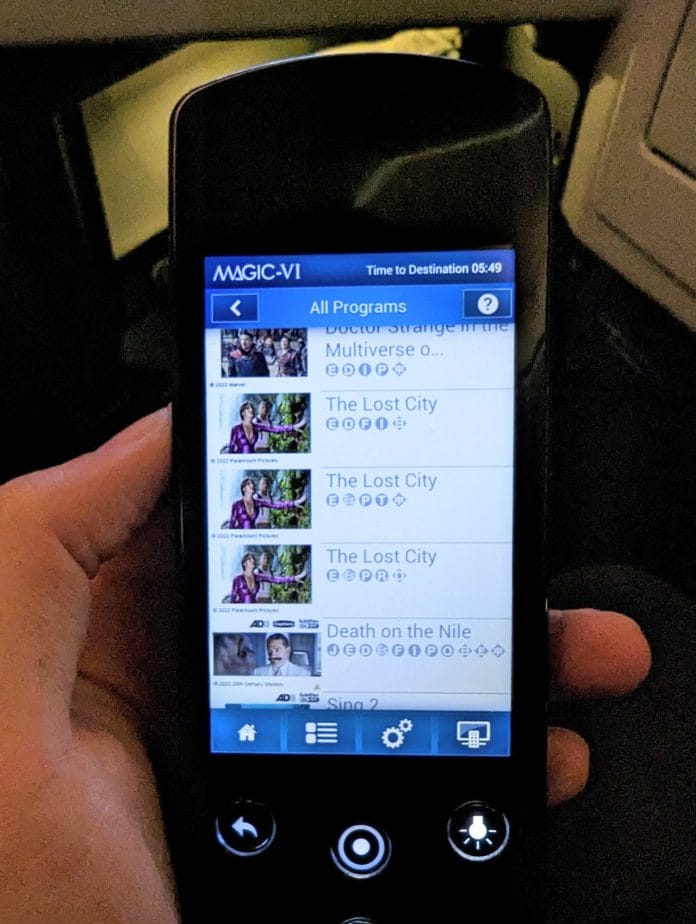
Noise cancelling headphones are provided, and shockingly given the Japanese obsession with presentation, come in a ghastly red plastic bag. These are the less-comfortable “on ear” type rather than the “over ear” cups, which also means poorer noise cancelling performance (don’t forget you’ll need to manually toggle noise cancelling via the switch on the right ear).
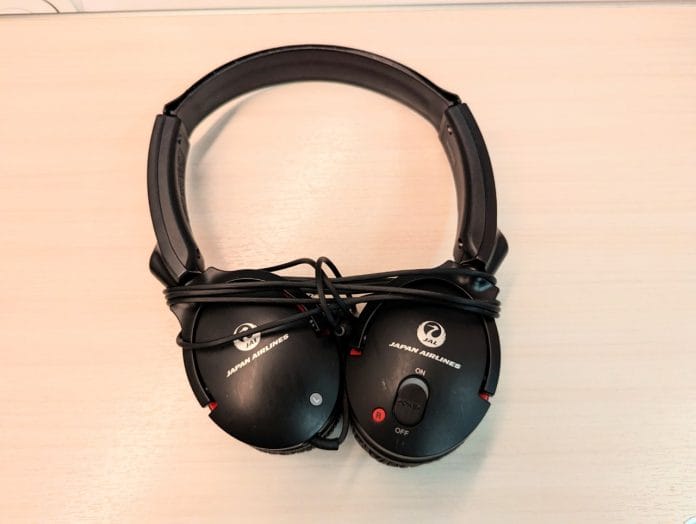
I ended up re-watching Boiling Point, where Stephen Graham puts in an extraordinary performance. I’ve been told it’s a painfully realistic depiction of the stress of running a professional kitchen, so if your only knowledge comes from reality TV, this might be quite eye-opening.
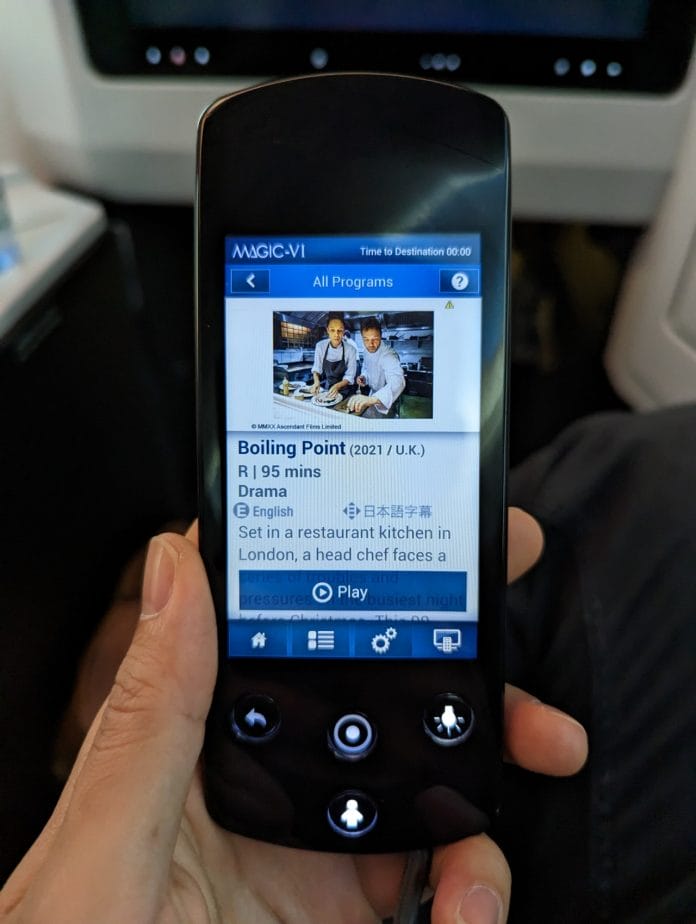

Sleep Experience
Business Class seats deploy into flat beds about 2m long. Since this is a reverse herringbone arrangement, you’ll be sleeping at an angle to the aisle (but still parallel to the seat, unlike some of SIA’s Business Class cabins).
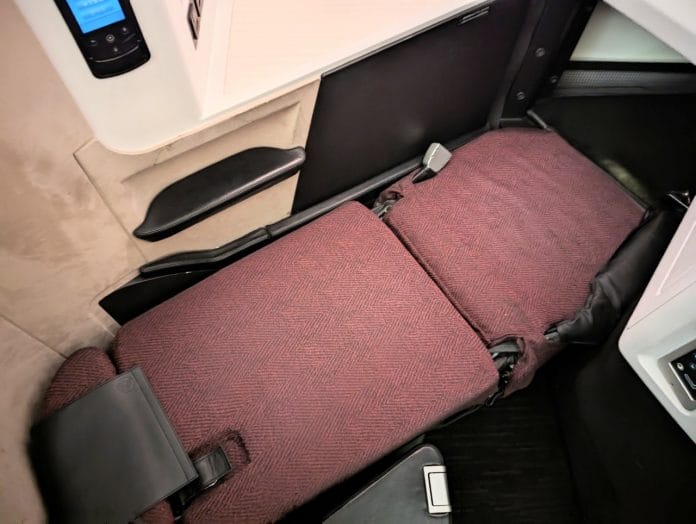
I mentioned earlier that the SKY SUITE III is extremely narrow, and I hope the photo above brings that out. Side sleepers may find it acceptable, but if you normally sleep on your back and like to stretch your arms out, you won’t find much joy here.
JAL does not provide a mattress pad on flights from Singapore, which is unfortunate since the seat’s surface is rock hard (and this coming from someone who enjoys a firm mattress). It was difficult to find a comfortable position to fall asleep, and a lot of tossing and turning ensued.
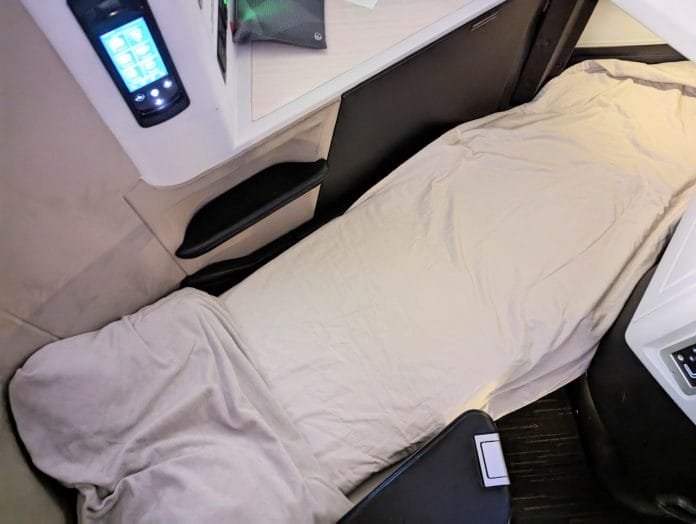
So I’d call this a pretty poor sleep experience overall. I drifted in and out of sleep, perhaps getting at best an hour.
Wi-Fi
Japan Airlines offers inflight connectivity on the vast majority of its international flights, including the B787-9.
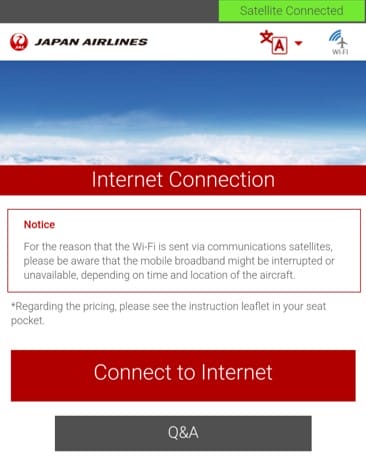
All packages are time-based instead of volume-based, giving you unlimited data for a given period.
📶 JAL Wi-Fi Pricing
Duration
Cost
1-hour
US$10.15
3-hours
US$14.40
24-hours
US$18.80
JALCARD holders enjoy discounted prices of US$9.15/ US$12.95/ US$16.80 for the 1/3/24 hour plans respectively
The connection remained stable throughout most of the flight, and I was impressed by the speeds which were as high as 15 Mbps down and 0.9 Mbps up.

One important thing to note is that Japan Airlines does not offer mobile network connectivity in its cabin. This matters in case you’re trying to receive an SMS OTP for online banking or shopping.
Toilets

The 52 Business Class passengers have three lavatories in their section- one in the forward section, and two more between the forward and rear sections.
All are equipped with baby changing stations, touchless flushes and taps, and bidet seats.
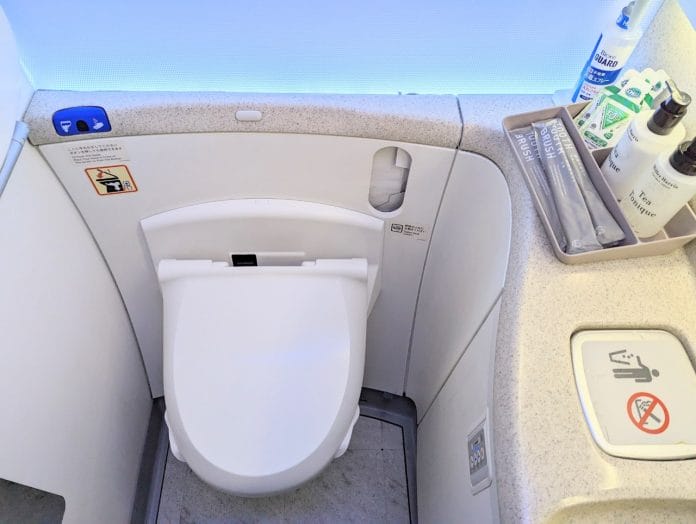
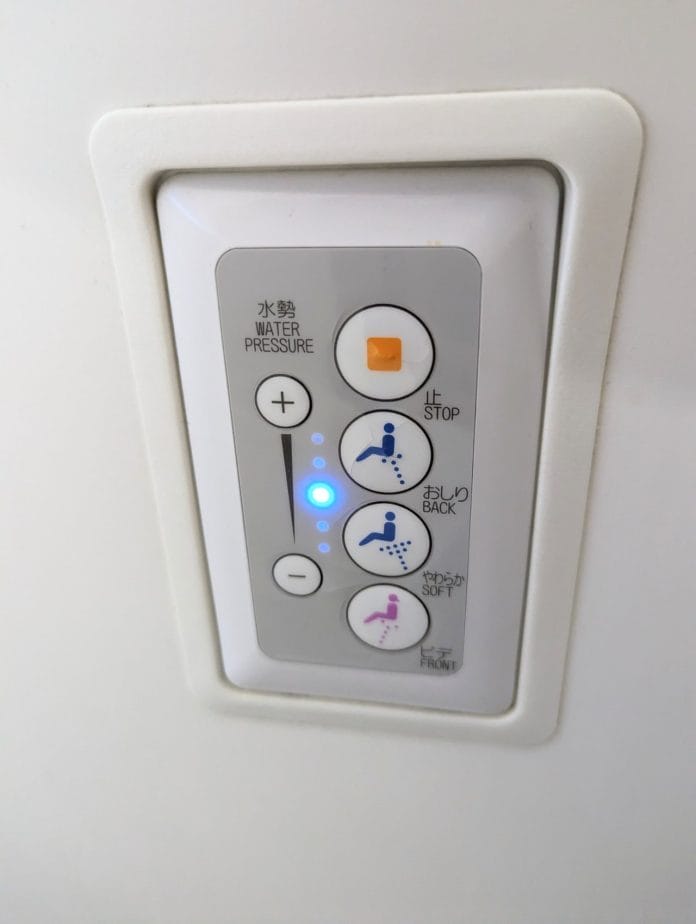
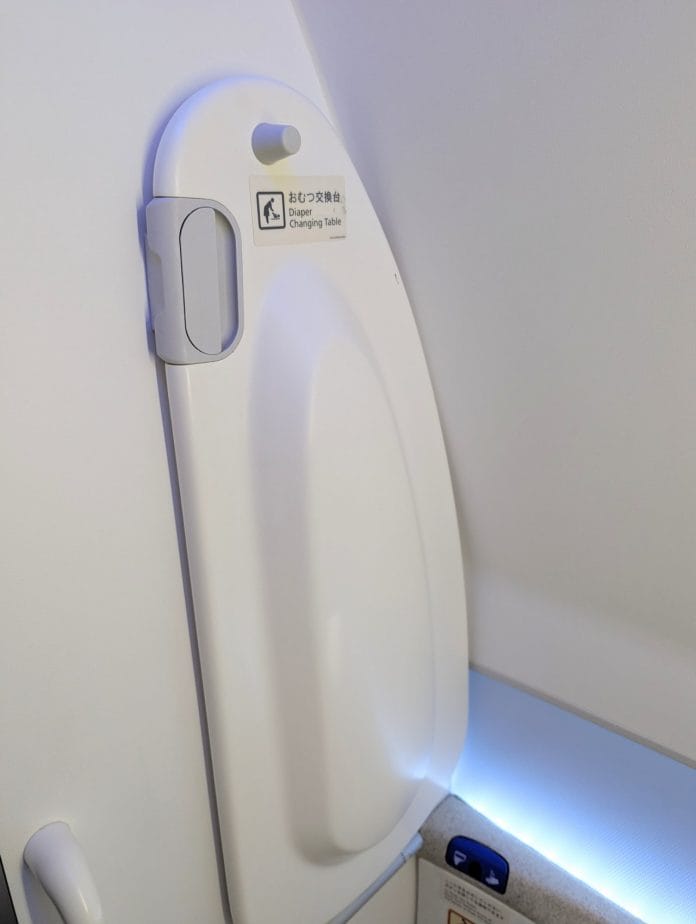
Bathroom amenities included toothbrush kits, individual sachets of mouthwash, and Miller Harris Tea Tonique lotion and cologne.
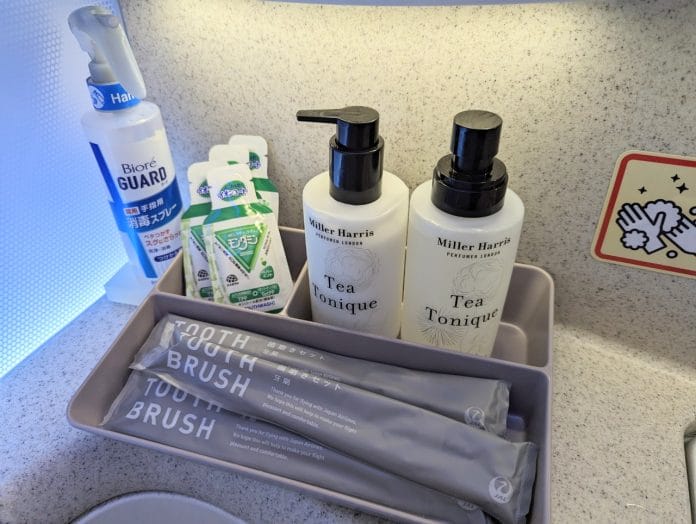
Conclusion
I don’t think I’d have been as acutely aware of the SKY SUITE III’s shortcomings on a daytime flight, but it’s readily apparent during a red-eye. The cramped seat, hard sleeping service and lack of mattress pad make it difficult to rest, a problem only compounded by the “1.5 meals” service routine.
Japan Airlines could use an upgrade to its hard product, especially in light of what its competitor ANA is offering.















![Toni Kroos là ai? [ sự thật về tiểu sử đầy đủ Toni Kroos ]](https://evbn.org/wp-content/uploads/New-Project-6635-1671934592.jpg)


